The Haswell Ultrabook Review: Core i7-4500U Tested
by Anand Lal Shimpi on June 9, 2013 9:00 AM ESTCPU Performance
With Haswell on the desktop we showed a 0 - 19% increase in performance over Ivy Bridge at the same clocks. With Haswell ULT, similar parts have identical turbo frequencies but Haswell does drop the base clock by 100MHz in this case. There’s also a lower TDP, and that TDP now includes the PCH as well, potentially decreasing the time spent in max turbo.
The end result is effectively no gain in performance across our benchmarks. PCMark 7 and single-threaded Cinebench show a 3 - 6% increase in performance, while multithreaded Cinebench and x264 show a 3 - 5% decrease in performance.
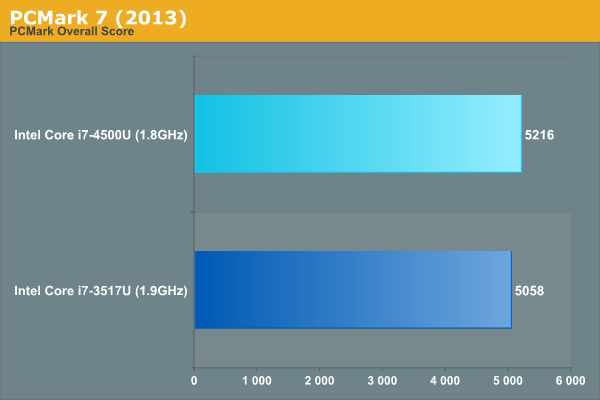
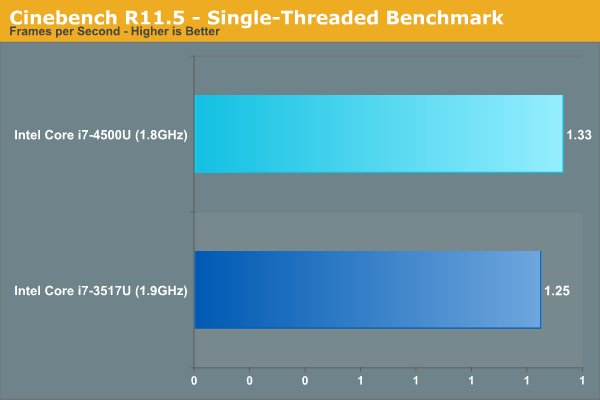
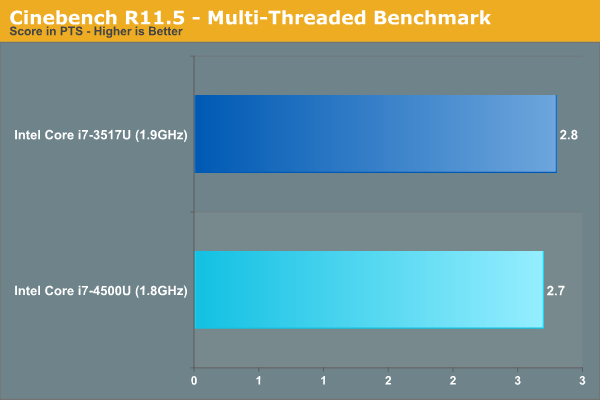
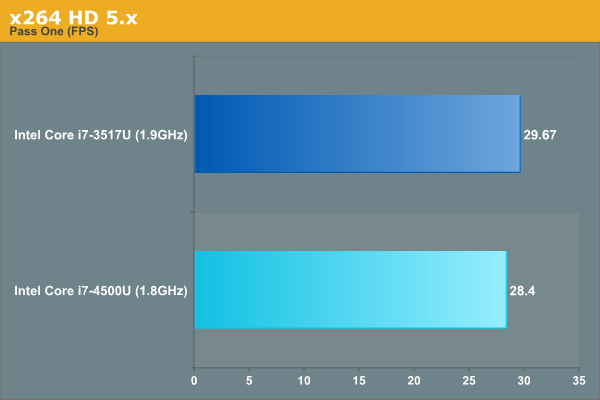
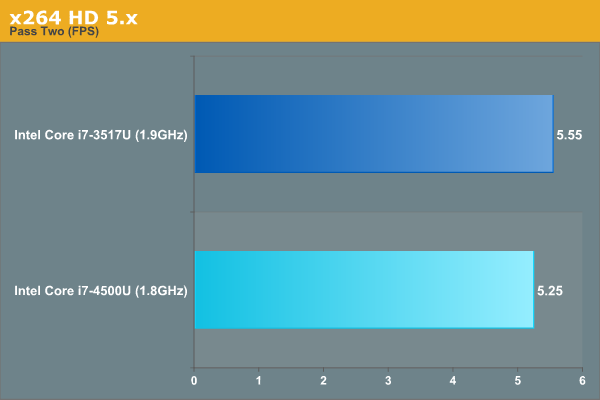
As we saw in our battery life tests, it looks like there are some larger performance gains to be had in power limited scenarios. The explanation there makes sense. Haswell ULT’s lower TDP may cap max frequencies more than on Ivy Bridge, but at lower frequencies the CPU cores are less likely to bump into the chip’s TDP limits - allowing Haswell’s IPC advantage to really shine. When plugged in however I wouldn’t expect CPU performance any different from Ivy Bridge.
| CPU Performance Comparison | ||||||||
| PCMark 7 | Cinebench 11.5 (single threaded) | Cinebench 11.5 (multithreaded) | x264 5.0.1 - 1st pass | x264 5.0.1 - 2nd pass | PCMark 8 Home (Power Saver) | PCMark 8 Creative (Power Saver) | ||
| Core i7-3517U | 5058 | 1.25 | 2.8 | 29.67 | 5.55 | 1595 | 1391 | |
| Core i7-4500U | 5216 | 1.33 | 2.7 | 28.4 | 5.25 | 1777 | 1583 | |
| Haswell Advantage | 3.1% | 6.4% | -3.5% | -4.3% | -5.4% | 11.4% | 13.8% | |










87 Comments
View All Comments
warezme - Monday, June 10, 2013 - link
"the processor graphics story by finally delivering discrete GPU class gaming performance". I hate this summation being thrown around, as I'm sure it will get re quoted somewhere as gospel. It is definitely NOT discrete GPU class gaming performance in any shape or form. There should be a limit to what is considered discrete GPU performance, like maybe 30-60FPS at, at least 1600x900 resolution and game settings across the board for all games set to Medium. That is not crazy or unreasonable for a true discrete GPU you would actually go out and buy. It shouldn't be unreasonable than to expect that in a built in GPU that is sold as "discrete GPU" quality.gnx - Monday, June 10, 2013 - link
Kudos! You have to love AnandTech for providing such detailed analysis, so soon after Haswell was made public!But it does seem that Haswell for Ultrabooks isn't so revolutionary as Intel seemed to imply. Not that we have much of a choice, since ARM isn't an option, and AMD doesn't provide much of an alternative, but I was personally hoping for more from Haswell.
Maybe it's change the equation for Windows Tablets? look forward to more from AnandTech!
Kiijibari - Monday, June 10, 2013 - link
Can you please add Wh numbers in the Battery Life Test graph (http://images.anandtech.com/graphs/graph7047/55504... or normalize them at least like in the previous tables? Seems to me that you compare 2 different batteries there. Haswell is great sure, but not THAT great ;-)Yes it is explained in the text below, but a picture not matching the numbers in the text is useless and misleading. A picture should be worth more than 1000 words and not demand reading 1000 words of explanation ;-)
broccauley - Tuesday, June 11, 2013 - link
Does anyone know what the status of "activity alignment" for power optimisation is on the Linux kernel and how it compares with Windows 8? I assume such techniques were added when the changes from the Android branch were merged?Henry 3 Dogg - Tuesday, June 11, 2013 - link
"And today, we had to track down a pre-production Haswell Ultrabook in Taiwan to even be able to bring you this review of Haswell ULT."And today, a day later, you can pick up a production Haswell ULT based MacBook Air in your local Apple store.
lhurt - Tuesday, June 11, 2013 - link
So are Platform Activity Manager (Windows) and Timer Coalescing (OSx) two different OS implementations of the same idea, to take advantage of Intel's Power Optimizer and are Haswell cpus required to get the benefit?fteoath64 - Saturday, June 15, 2013 - link
"Any hopes for pairing a meaningfully high performance discrete GPU with Haswell ULT are dead."This is Intel's method of CLOSING other discrete GPU solution on their cpus towards the future. This is a predatory move and premeditated !. Just stop buying their chips as this is forcing users into a proprietary path using their inferior gpu technology. It is a selfish and disgusting move. Now ARM is going to cream them on the desktop side as well soon and server side in time.